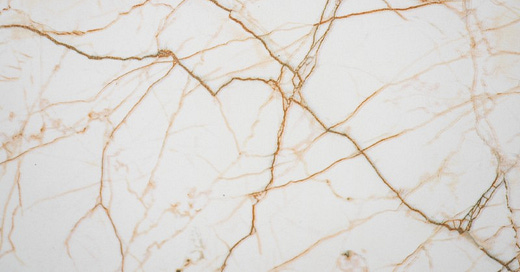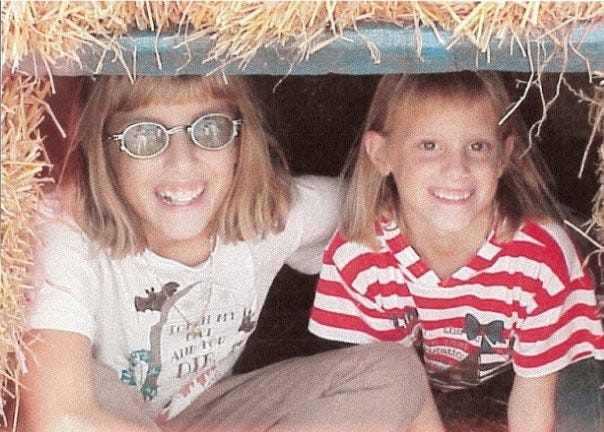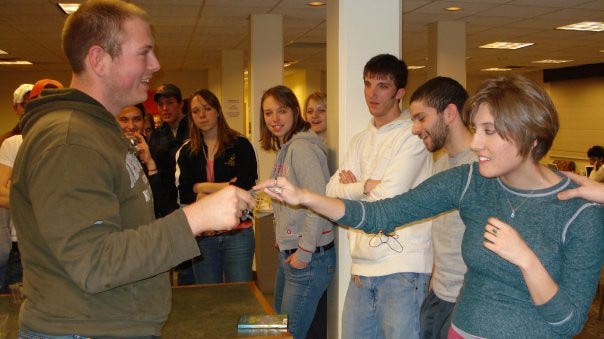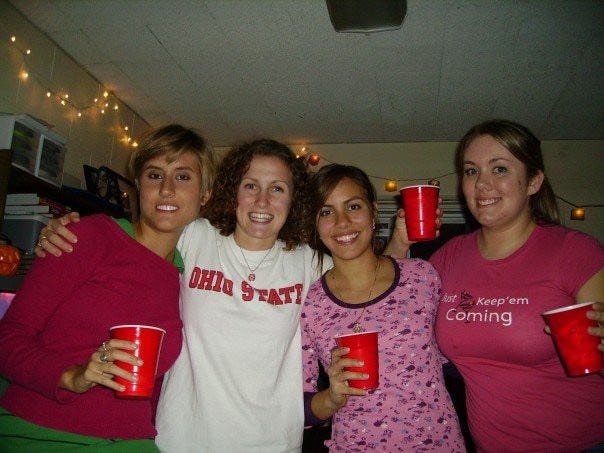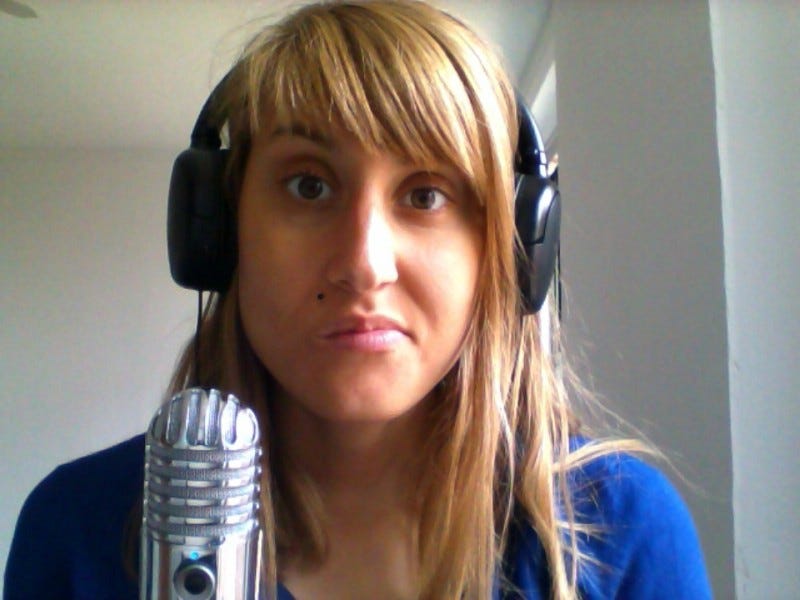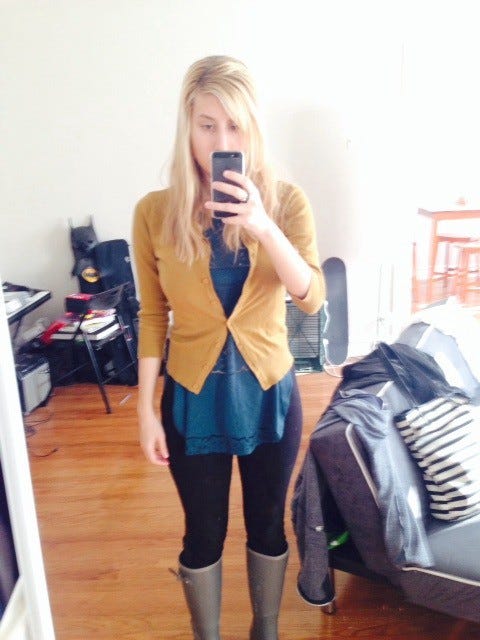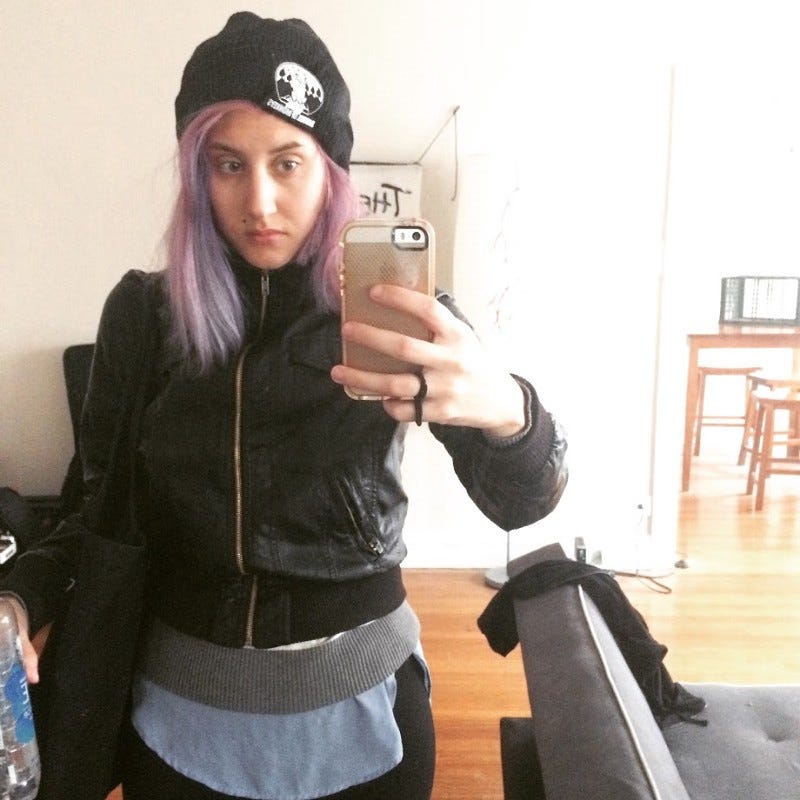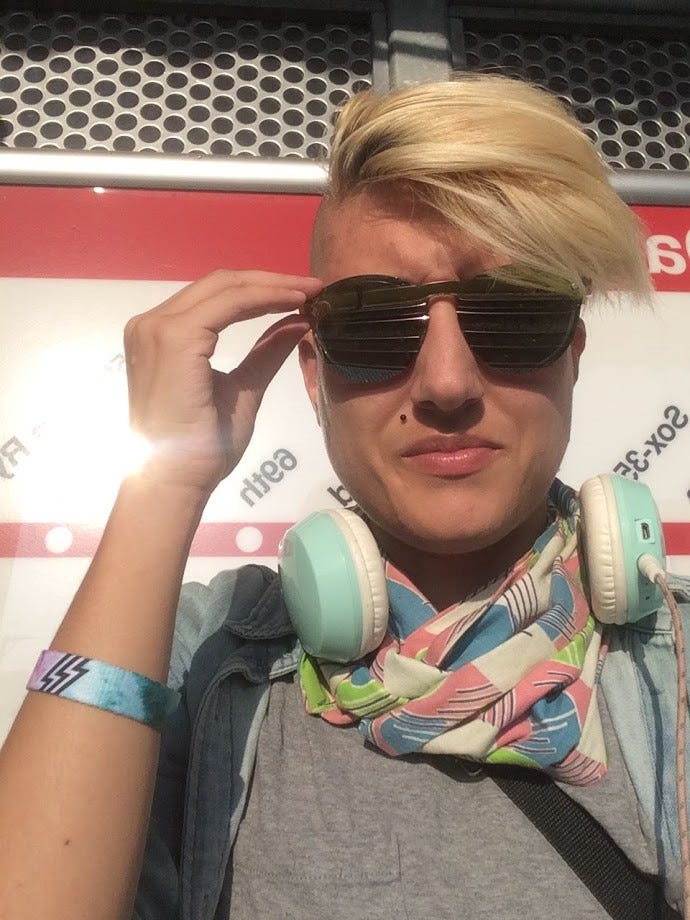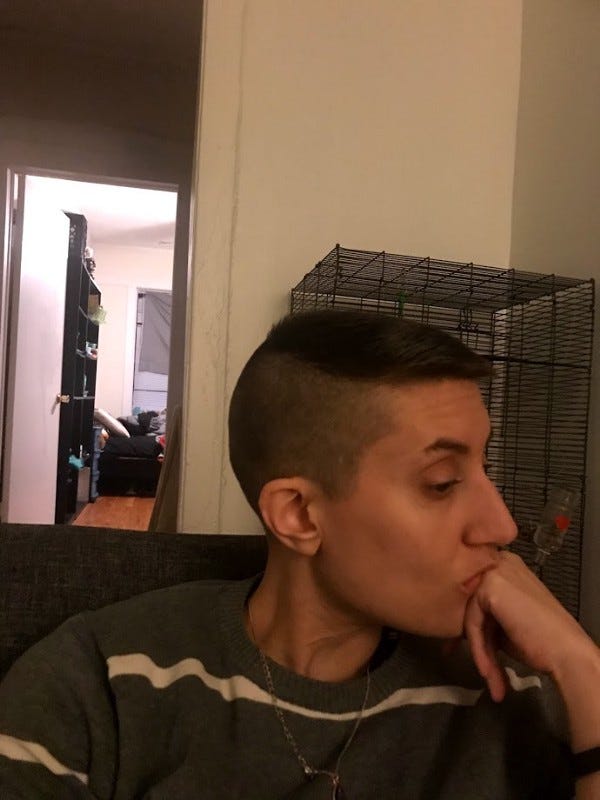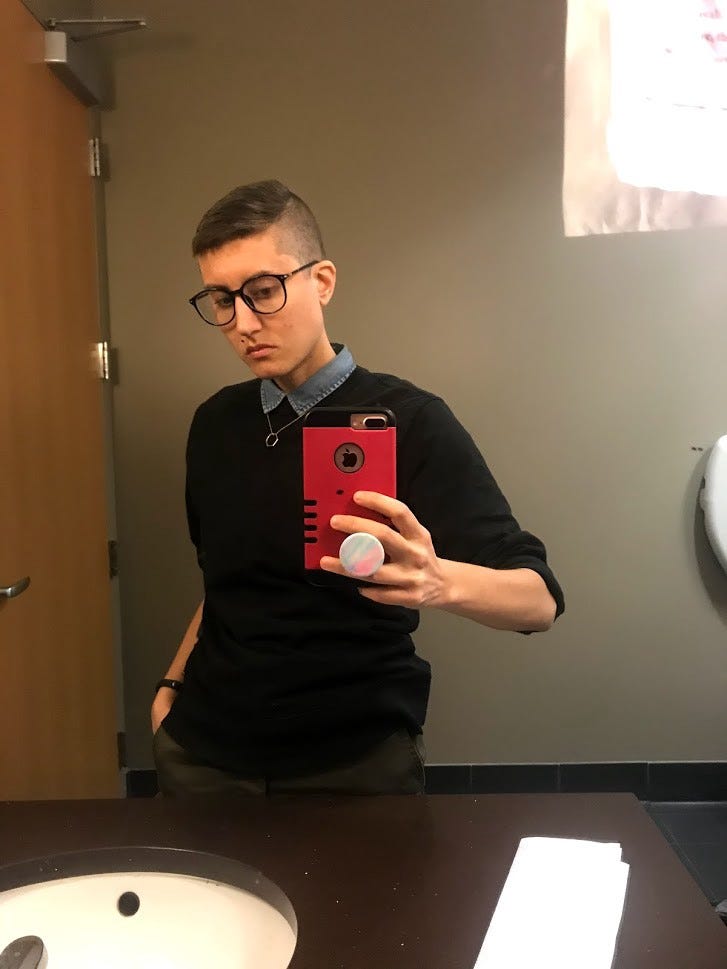A creative collaboration with blades and time.
TW: Eating Disorder, Gender Dysphoria, Suicide Ideation
For the first 15 years of my life, my hair was cut by Gloria. Gloria had long acrylic nails and silver rings that clacked against the scissors beside my ear. She had curly, voluminous hair, and she wore tight jeans or yoga pants. She was incredibly buff and toned, with a Fran Drescheresque fashion sense: loud patterns, bright peacock colors.
She was chatty and outgoing, and she always gave me the exact same blunt, helmetish bob. For just about 15 years. I didn’t like it, and I tried not to think about it. I didn’t really realize I had any other options. That just about sums up my whole relationship to my physical form at that age, really.
And then I caught Gloria cheating on her husband with my kickboxing instructor Brian. And everything changed.
Okay, I didn’t see them having sex or anything like that. I just caught them together in Brian’s bright yellow Jeep, takeout in their laps, guilt on their faces as soon as they saw me.
For some reason, Gloria felt the need to explain away my sighting. She talked to my mom at her next hair appointment, stressed that she hoped I wouldn’t be confused by what I had seen, acted guilty, acted uncomfortable.
I didn’t really give a shit. I was a teenager and the idea that any of the adults around me were actually having sex that they enjoyed came as a bit of a thrill. I had already known that Gloria and Brian were friends, had seen the frosted blonde tips she had given him at the salon, had seen her leaving one of his classes. I’d be alone in a room with Brian, and felt a strange lasciviousness in the air, though nothing had happened, and I had heard from some kids at the local pool that Brian had fucked some other married woman, also a student at his gym. I wasn’t in the business of exploding somebody’s marriage over a sighting in a Jeep.
Still, I was getting sick of the helmet haircuts. And so it seemed like a natural enough time to stop going altogether.
And I didn’t get my hair cut by anyone other than myself for another 15 years.
…
As a teenager, I started cutting my hair without a specific outcome in mind. It was a purely tactile, sensory experience. Left alone, my hair grew in thick. It was dry and many-stranded and bone-straight, and by the time it reached my neck, it was unwieldy and hot. Once, Gloria had layered it in a delicate, even sexy way, allowing the hair to cascade around my face and give it movement. Every other time she cut it, it was a squarish bob. I wanted to replicate the one good hair cut she had given me. Maybe even improve upon it.
So I set about thinning it. I would stand before the mirror, cheap paper scissors in hand, and jab at the back and the sides based on instinct and and feel. Hunks flew to the floor and gathered in the sink. It made a horrible mess that my mom rightly hated. As I worked, I brushed through my hair, tosseled it, looked it over in the mirror from all angles. It was imprecise work, but eventually the resulting mess was shapely and lightweight, framing my face exactly as I wanted it to.
That first summer, I got all kinds of compliments on my self-given, self-maintained haircut. Older women especially liked it. I worried that meant the cut was too mature, too aging, but I still loved the shortness of it, it’s manageability, the way it made me look just a bit more androgynous. The cut revealed cheekbones and a square jaw that my former long, rigid curtains of bobbed hair had obscured. I could recognize myself. And I loved the freedom of it.
…
I made some mistakes, don’t get me wrong. Once, in high school, I sliced through the hair at the front of my crown, leaving a little stubby section that was only about half an inch long, right in the center of my forehead. I had to part my hair to the side to cover the newly shorn patch, for months, until it grew back. Sometimes I let the back grow too long, creating a mullety shape. Sometimes the layers didn’t sit right, and my head looked like a mushroom.
What I learned, however, was that when you cut your own hair, any problem is easily remedied. Going to a salon requires scheduling an appointment, giving yourself over to the whims and mercies of another person, and then coping with the aftermath for six or eight weeks.
But once I started cutting my own hair, I could work on it at any time. Sometimes I’d cut my hair two, three times a week, re-consulting the mirror, seeing how the new style I had created varied from one day to the next. If I cut too much on one side, I could correct it the next day. If a cut looked great on week 1 but grew out funny by week 4, I could just change it. If I didn’t cut it short enough, I could go shorter.
Each day I would scrutinize my hair before the mirror, and decide whether work needed to be done. My hair became an ever-evolving, expressive work. A sculpture to which raw material was added, naturally, with each day of growth, and from which I could strip away material whenever I liked. I became intimately aware of the lines of my face, the shape of my jaw, the strips of hair that naturally wanted to fluff up, or sit flat. I was no longer the passive child in the stylist’s chair. I was an agent in my own self-creation.
…
My hair stayed short for most of college. I shared a dorm with three girls, and my hair littered the floor of our tiny bathroom. Once, my boyfriend at the time asked me to cut his hair, and we set up a little barbershop in the hallway, with a trash bag over his shoulders to collect the strands that fell.
I had a breakdown in the middle of the cut. Started doubting myself. I went too straight across the front, gave him baby bangs without meaning to. I had to stop because I was crying so hard, and a girl from the floor above us came down to finish the job. Cutting his hair was not like cutting my hair. I didn’t know the landscape, the texture. I couldn’t touch the back and feel when it was comfortably light. I could not read his mind.
Cutting my hair has always been intuitive, and impulsive, a messy art of searching for myself from deep under the thicket, rather than a craft.
…
I started growing my hair out in graduate school. It wasn’t because I wanted long hair. I was just distracted. I was depressed, and alone in a new city, and toiling forever at a sticky desk in a windowless office. My apartment was dark and filled with awful memories of breakups and bad sexual encounters and crying jags. I didn’t want to stand in front of the mirror and consider myself. I didn’t want to work constantly, and lovingly, on myself anymore.
And so the hair grew out. It grew out dry and damaged and uninspired, and it was always flying in my face.
In some pictures, the haircut looks lovely. It was easy to manage, familiar, and less complicated to style than a true long haircut. During that time in my life I was very conventionally attractive, super-sad and super thin. I was pining after a guy who was constantly cheating on me, and I was trying desperately to change my body into something that both he and I could tolerate. He liked that I was starving myself. He liked that my hair was getting longer. It reminded him of the ex-girlfriend he was constantly cheating on me with. And so my hair grew and grew, unattended, passive, and unhealthy.
…
I got a bit better. I started dating someone who was caring and gentle, but I still kept myself locked away alone in my studio apartment most of the time. I worked on my dissertation. When I started teaching classes, I got a bit paralyzed with self-doubt. So many eyes were on me. I wondered if the students could tell that I was a shy, lonesome loser.
One night, at about 1 am, I found myself in the bathroom with scissors, impulsively cleaving bangs into my hair. The result was asymmetrical, amateurish. But I felt enlivened by it. The bangs were something I could continue to sculpt and improve upon as they grew out. I got quite a few compliments on the new cut from my students. My sense of self-authorship came back, slowly.
My hair remained long for several more years, from then on, I engaged with it. I started learning about deep conditioners and dyes. I decided I wanted to go blonde, and began bleaching it — first with hydrogen peroxide, then with box bleach. If I didn’t like the color, I just dyed or toned it again within a couple of days. I painted balayage into my roots. I made my hair soft, luminous, golden. I was a work of art.
A wonderful and sometimes terrifying intimacy with my own appearance developed yet again. I kept my hair manageable with a razor and fabric scissors, purple shampoo and cream conditioner and dye. My eating disorder had begun to slowly subside, as had other bad habits, such as compulsively picking at my skin and hitting myself on the legs with a hairbrush. In their place, I found something else to focus on, a way to create through destruction.
…
I knew at this point that I was nonbinary, but I hadn’t told anyone except for friends on the internet. There was a feeling of uncanniness that swelled whenever I looked at myself in the mirror. When people tried to take my photo, all I could do was dive out of view and cry.
I hated the feeling of long hair, but I liked the appearance of it just fine. I knew intellectually that I made for a really conventionally attractive woman. I also knew that living as a conventionally attractive woman was corrosive to my being. I was living a lot of lies, in a lot of ways, and it was making me sick.
The night that Trump was elected, I sobbed in the bathtub and thought about wanting to kill myself. I knew I wouldn’t actually do it. I’ve never made an attempt. Still, I’ve spent many lonesome nights clutching myself close and praying for death. That night was one of the worst instances in recent memory. Instead of doing anything rash, I reached for a box of purple dye that I had bought a few days before.
The purple looked great. Maintaining it took a lot of effort. I had to cut the frayed ends and enlivened the color with toner and dye on a weekly basis. This provided me with a welcome, hands-on distraction from how miserable the election had made me. And the damage done by the bleach gave me an excuse to make an even bolder change: cutting it all off.
…
In 2017, I got the first (and so far only) professional haircut of my adult life. It had been years since I’d cut my own hair dramatically short, and I doubted my own ability. I had a friend at the time who was a stylist. I brought her a picture of Halsey and she gave me a classic pixie.
I really liked how it looked. More importantly, I loved how it felt. No more snarls of tangles to work my brush through. No heavy weight. No scratchy split ends. And from some angles, with the hair styled just so, I looked boyish. I wanted that boyishness to go further. So I bought a razor comb, and eventually a pair of clippers, and set about shaving the sides of my head myself.
Shaving and clipping my hair was revelatory. Up to that point, my hair-cutting had always been an imprecise and inefficient process, driven by a pair of scissors that weren’t even made for hair, plus my own grasping, guessing touch. But clippers were fast, and easily customizable! Pick a length, snap on an attachment, and run the buzzing thing against your head! The sound of the clippers chewing through my hair gave me ASMR. The process was speedy, and the mess was just a few little specks dumped into the garbage.
I started with a tuft of blonde, flowing hair in the center, and a skin-short shave on the sides and back. I styled the top with dry shampoo and time, and I looked like a beautiful cockatiel. People complimented it all the time — a woman once pulled over her car just so she could walk up to me and say she loved it. And it was an ideal starter haircut for a newly out nonbinary person. Slicked back, I looked masculine; with the fringe covering my forehead, I looked feminine. It was bold and adorable and perfectly me. It was an ongoing process of layering and bleaching. It was an expressive art.
Eventually though, I wanted to go with something more masculine. I wanted a change. So after about two years, I took the clippers to the top and created something new. I was getting too good at my old haircut, anyway. Too comfortable. I like myself better when I am evolving, being sculpted into something new.
…
I’ve heard from many many queer people over the years about the frustrations of getting a hair cut. If you’re assigned female at birth, and look like you are, nobody wants to give you an androgynous or masculine haircut. Barbers will turn you away from their shop; stylists will give you a vague, sloppy Kate Gosselin style no matter what you ask for. If you’re assigned male at birth, they’ll try to persuade you to get some kind of crew cut or extreme undercut.
But I’ve never had to grapple with that problem, because I’ve cut my hair myself. In my bathroom, with my clippers in hand, I can go as short as I want, can make the silhouette as square or extreme as I like. I can make a mistake and correct it easily.
I buzzed my entire head of hair down to almost nothing this January, and got to watch and adapt as the raw material grew back in. It was like learning an entirely new artistic medium. At one length, the hair stands up straight and looks fuzzy, even tennis-ball-ish. But give it a couple of weeks, and it’s swirling in all different directions. Wait a few weeks after that and you have something long enough to sweep to the side with a bit of pomade.
Some of the stages have been prettier than others, but they’ve all given me an opportunity to stand before the mirror, work my hand over my scalp, and regarding my jaw, my nose, my eyebrows, my cheeks. Hair-cutting is an art that changes as your own understanding of yourself does. It is an ongoing, meditative work, in which I’m the creator and the product, and my only creative collaborator is time.
I am constantly growing, my body forever extruding more cells of me. And I’m forever going to be cutting through the excess, the history, the trauma, the confusion, casting aside the old, revealing the things that I would like to keep. I am my own huge hunk of stone. I am the Galatea that I find underneath.

